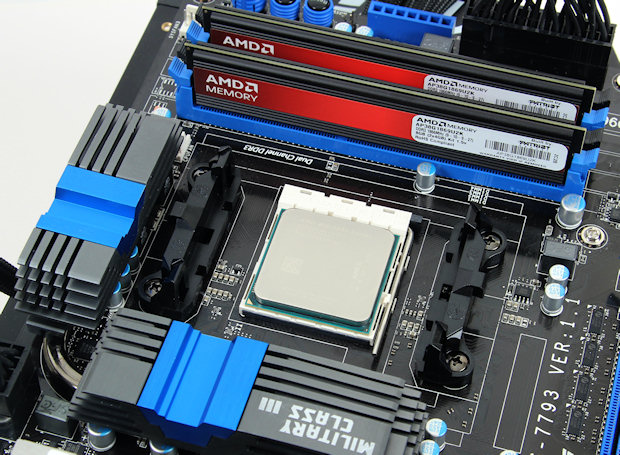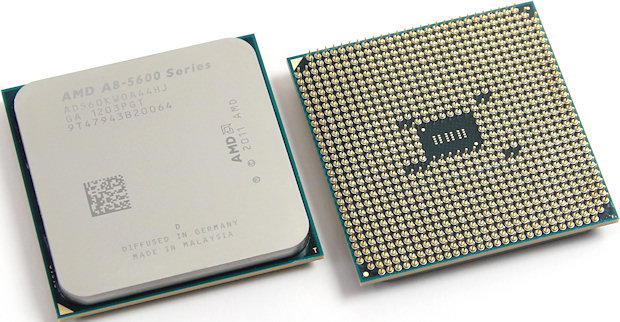
AMD's Trinity chip is making a debut, but it's not exactly a fresh face. We reviewed the mobile version of Trinity back in May and had mostly positive things to say about it. The second generation of AMD's do-everything, converged APU offered solid progress over the first-generation "Llano" chip on many fronts. Not too long after Trinity's mobile release, desktop versions of it started shipping exclusively in systems from large PC makers. Those wishing to build their own systems based on the chip, or to buy them from smaller PC vendors, had to wait. AMD took its time ushering this chip into broader sales channels, but the time is finally upon us. Trinity is now available as a retail product, as are motherboards based on the new Socket FM2 platform.

Trinitarian doctrine
Since Trinity is a known quantity, we won't recount its architecture in great detail. You can read our review of the mobile version for that info. The basics are fairly straightforward, though. Trinity is, in many ways, a direct answer to Intel's Ivy Bridge processors. The two CPUs incorporate many of the same functions, including things like PCI Express connectivity and graphics that were formerly delegated to support chips. The name of the game is integration, because integration saves power, reduces costs, and shrinks the footprint of a system. The latest PC processors are beginning to look very similar to the system-on-a-chip (or "SoC") products that power smart phones and tablets.

Although Trinity is built on the same 32-nm SOI process technology as its predecessor, Llano, it offers architectural upgrades all around. The four older Phenom-era CPU cores have been replaced by dual "Piledriver" modules. Each module has two integer cores, a beefy-but-shared floating-point unit, and 2MB of shared L2 cache. Piledriver is the code name for an updated version of AMD's still-new Bulldozer microarchitecture, with improvements to its per-clock instruction throughput and voltage-frequency response. Trinity brings Piledriver to the desktop for the first time.
AMD has refreshed the Radeon graphics on this chip, as well, moving from the older VLIW5-style shader core used in the Radeon HD 5000 series to the VLIW4 shaders from the Radeon HD 6900 series. This isn't the latest GCN architecture from today's Radeons, but it supports a full DirectX 11 feature set and should be an incremental improvement in efficiency.
The companion video acceleration block, however, is ripped right out of the Radeon HD 7000 series, and there have been updates to the display and memory controllers, as well. In fact, the only item of note that isn't really up to date is the PCIe connectivity, which remains at Gen2. Third-gen PCIe offers twice the data rate.
One thing that doesn't fit easily into the diagram above is the more refined integration of these different pieces. Trinity has considerably fewer visible seams compared to Llano. Among the major improvements is power management. Trinity can dial back the clock speed and voltage of its graphics component in response to CPU-heavy workloads. Llano could rein in the CPU when graphics-heavy workloads required it, but not vice-versa.
Plenty o' flavors

| Model | Modules/ Integer cores |
Base core clock speed |
Max Turbo clock speed |
Total L2 cache capacity |
IGP ALUs |
IGP clock |
TDP | Price |
| A10-5800K | 2/4 | 3.8 GHz | 4.2 GHz | 4 MB | 384 | 800 MHz | 100 W | $122 |
| A10-5700K | 2/4 | 3.4 GHz | 4.0 GHz | 4 MB | 384 | 760 MHz | 65 W | $122 |
| A8-5600K | 2/4 | 3.6 GHz | 3.9 GHz | 4 MB | 256 | 760 MHz | 100 W | $101 |
| A6-5500 | 2/4 | 3.2 GHz | 3.7 GHz | 4 MB | 256 | 760 MHz | 65 W | $101 |
| A6-5400K | 1/2 | 3.6 GHz | 3.8 GHz | 1 MB | 192 | 760 MHz | 65 W | $67 |
| A4-5300 | 1/2 | 3.4 GHz | 3.6 GHz | 1 MB | 128 | 724 MHz | 65 W | $53 |
| Athlon X4 750K | 2/4 | 3.4 GHz | 4.0 GHz | 4 MB | - | - | 100 W | $81 |
| Athlon X4 740 | 2/4 | 3.2 GHz | 3.7 GHz | 4 MB | - | - | 65 W | $71 |
The table above shows the full lineup of Trinity desktop processors. Note the 65W and 100W power envelopes, just the same as the prior-gen Llano products. With the move to 22-nm process tech, Intel reduced its desktop power envelopes; even the most expensive Core i7 has a peak power rating of just 77W. AMD has supplied us with two chips to review: the A8-5600K and the A10-5800K. Both are K-series parts with unlocked multipliers for easy overclocking, but they unfortunately both have 100W TDP limits. We suspect the 65W versions may be more appealing to many folks.
Trinity APU pricing doesn't rise above the $122 mark. AMD has kept the price tags modest, a tacit acknowledgement of the performance picture. By contrast, the Ivy-based Core i7-3770K sells for $332, well over twice the price of the A10-5800K.
For what it's worth, we've neglected to list the complex suite of Radeon model numbers attached to the integrated graphics. The A10 series, for instance, has Radeon HD 7660D graphics, and the A8 series has Radeon HD 7560D graphics. What you need to know, really, are the ALU counts and clock speeds shown above. Oh, and it's worth mentioning that most of these APUs support AMD's Dual Graphics feature. That is, they can pair a low-end Radeon graphics card with the IGP in a CrossFire-style multi-GPU config. That's not our favorite option given the added complexity, the asymmetry between GPUs, and the potential for multi-GPU micro-stuttering, but it is an option for those who want it.
reader comments
65